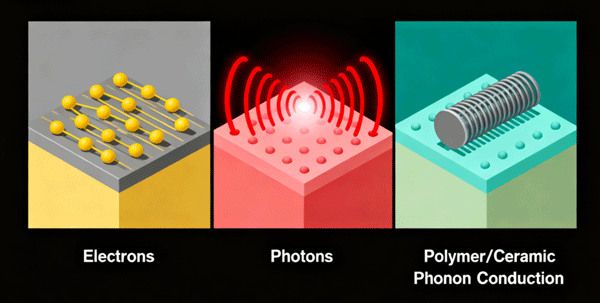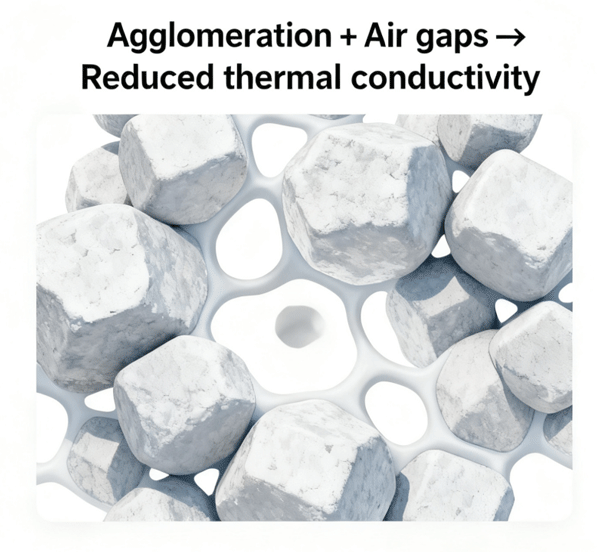



Wärmeleitmaterialien werden zwischen Heizkomponenten und Kühlkörpern platziert und erfordern sowohl eine hohe Wärmeleitfähigkeit als auch eine gute elektrische Isolation. Die Wärmeleitfähigkeit eines Materials hängt eng mit der Bewegung seiner mikroskopischen Partikel zusammen. Wärmeleitung erfolgt primär über drei Mechanismen: Elektronenleitung, Photonenleitung und Phononenleitung. Metallische Werkstoffe nutzen vorwiegend freie Elektronen zur Wärmeleitung. Photonische Wärmeleitung findet hauptsächlich in transparenten Glaswerkstoffen Anwendung. Polymere und Keramiken leiten Wärme primär über Phononen. Die zufällige Verschlaufung der Polymermolekülketten, die Polydispersität der Molekulargewichte und die Streuung von Phononen an den Molekülkettenschwingungen führen jedoch zu einer sehr geringen intrinsischen Wärmeleitfähigkeit.

Daher beruht die Wärmeleitung in Polymer/Keramik-Verbundwerkstoffen primär auf den keramischen Füllstoffen. Die Wechselwirkung zwischen den Atomen innerhalb ihrer Kristallstruktur lässt sich vereinfacht als Masse-Feder-System beschreiben. Dies ermöglicht es den Atomen, um ihre minimale potenzielle Energie zu schwingen und dabei Gitterwellen zu erzeugen, die die Phononenleitung ermöglichen und somit Wärme effektiver transportieren.
Um eine hohe Wärmeleitfähigkeit zu erzielen, müssen die keramischen Füllstoffe im Wärmeleitmaterial in Kontakt treten und sich aneinanderlagern, wodurch ein durchgehendes Netzwerk in der Polymermatrix entsteht. Der Großteil der Wärme wird über dieses Netzwerk übertragen, was die Wärmeleitfähigkeit des Polymerverbundwerkstoffs deutlich erhöht.
Eine zu hohe Füllstoffbeladung führt jedoch zur Agglomeration der Füllstoffpartikel und damit zur Bildung von Hohlräumen. Die extrem niedrige Wärmeleitfähigkeit von Luft (nur 0,0257 W·m⁻¹·K⁻¹) bewirkt eine Verringerung der Gesamtwärmeleitfähigkeit des Systems. Darüber hinaus können während der Anwendung Probleme wie schlechte Fließfähigkeit der Matrix, instabile Leistung und Neigung zur Phasentrennung auftreten.

Über Xiamen Juci Technology Co., LTD
Der Aluminiumnitrid-Füllstoff Das von Xiamen Juci Technology Co., Ltd. entwickelte Material bietet hohe Wärmeleitfähigkeit und elektrische Isolation und verbessert dadurch die Wärmeableitung in Harz- oder Kunststoffverbundwerkstoffen deutlich. Seine überlegene Leistung geht über das Wärmemanagement hinaus und zeichnet sich durch branchenführende Hydrolyse- und Alterungsbeständigkeit für erhöhte Langlebigkeit aus.
Kontakt:
Xiamen Juci Technology Co., Ltd.
Telefon: +86 592 7080230
E-Mail: miki_huang@chinajuci.com
Webseite: www.jucialnglobal.com